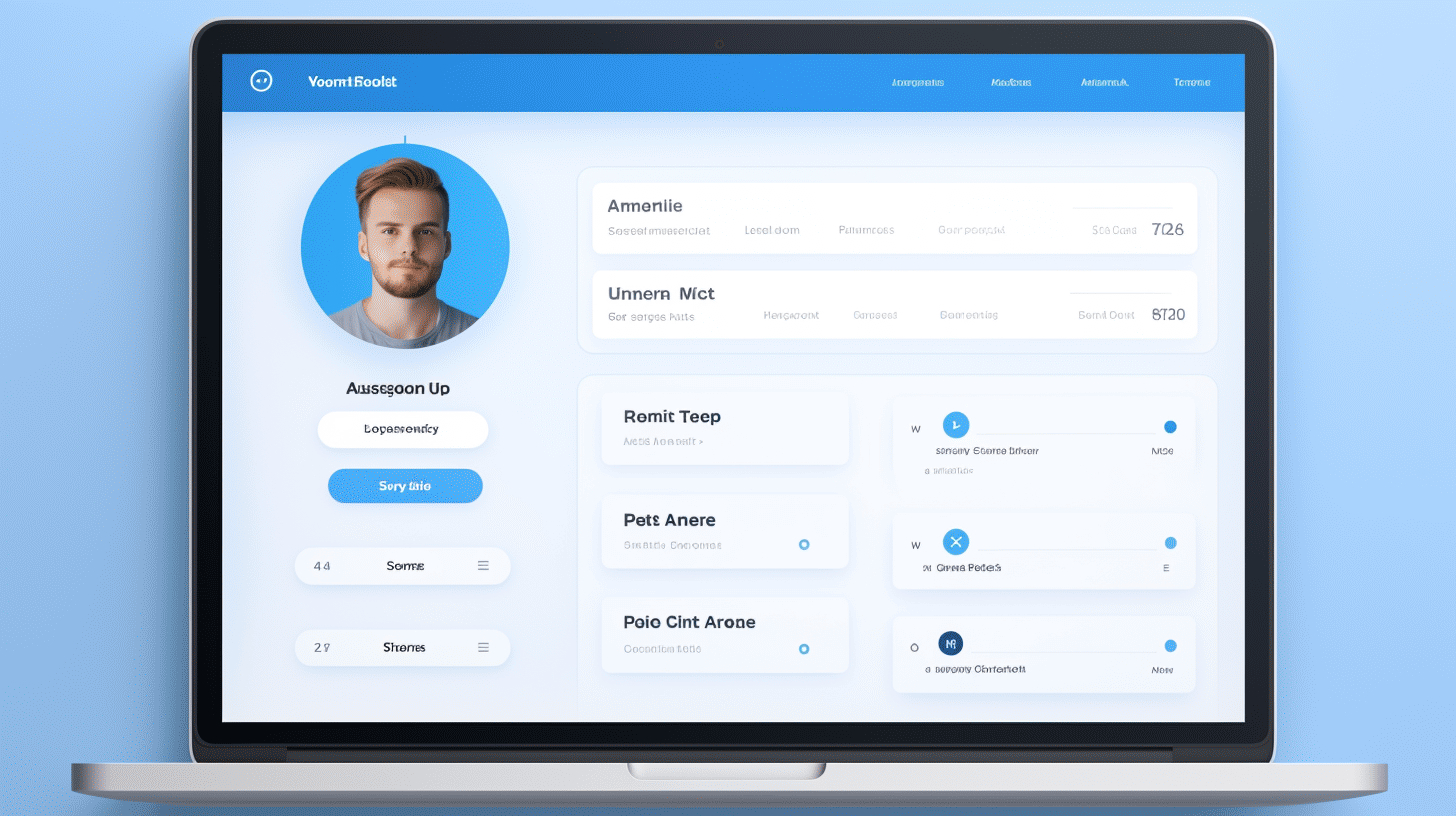在當今的數位環境中,創建優化的網站對於企業和個人來說都至關重要。精心設計的網站不僅能吸引訪客,還能提供無縫的使用者體驗。實現此目的的一種流行方法是結合使用 Headless WordPress 和 Vue.js。
Headless WordPress 是一種現代內容管理系統,將後端功能與前端呈現分開。這意味著開發人員可以自由使用任何前端技術(例如 Vue.js)來創建使用者介面和互動性。
另一方面,Vue.js 是一個多功能且功能強大的 JavaScript 框架,可讓開發人員建立動態且反應迅速的使用者介面。它與 Headless WordPress 無縫集成,是創建優化網站的理想選擇。
在本文中,我們將探討無頭 CMS 和無頭 WordPress 的興起,深入研究使用無頭 WordPress 和 Vue.js 的好處和特點,討論如何將 Vue.js 與無頭 WordPress 集成,探索無頭 WordPress 的流行前端框架,最後,引導您完成使用 Vue.js 和無頭 WordPress 創建自定義前端的過程。
因此,無論您是希望建立優化網站的開發人員,還是希望增強線上形象的企業主,本文都將為您提供開始使用 Headless WordPress 和 Vue.js 所需的見解和知識。讓我們開始吧! 💻🚀
Headless CMS 與 Headless WordPress 的興起
歡迎來到令人著迷的 Headless CMS 和 Headless WordPress 世界!近年來,這些尖端技術的採用大幅增加,徹底改變了人們創建和管理網站的方式。
無頭 CMS 採用
近年來,無頭 CMS 的採用率激增,自 2018 年以來,採用這種方法的企業數量翻了一番。但無頭 CMS 到底是什麼?
在傳統的 CMS 中,前端和後端緊密耦合,這意味著內容的顯示方式與 CMS 平臺本身直接相關。然而,在無頭 CMS 中,後端和前端是分開的,允許內容創作者只專注於創建和管理內容,而不必擔心如何呈現內容。這種解耦使開發人員能夠將內容傳送到任何管道或設備,提供無與倫比的靈活性和可擴展性。
Headless WordPress 的使用分佈
說到無頭 CMS 平台,Headless WordPress 無疑是先驅和市場領導者之一。但與其他提供者相比,它的使用情況如何?我們來看看分佈情況:
- Gatsby:基於 React、GraphQL 資料層、靜態網站產生器和 SEO 友善平台。
- Strapi:一個開源無頭 CMS,具有可自訂的內容結構和 REST 或 GraphQL API。
- Contentful:一個內容基礎架構平台,使開發人員能夠跨多個管道管理內容。
- Prismic:一個用戶友好的無頭 CMS,具有強大的寫作體驗和靈活的內容建模。
- Sanity:一種即時的、協作友好的無頭 CMS,具有直覺的開發人員體驗。
在這些頂級供應商中,WordPress 處於領先地位,佔據內容管理系統 (CMS) 市場份額的 65.2%。令人印象深刻,對吧?但它並沒有就此止步。根據 W3Techs 統計,全球有 43.3% 網站由 WordPress 提供支援。擁有如此龐大的用戶群和廣泛的外掛程式和主題,毫無疑問,WordPress 是許多人建立網站時的首選。
如果你想知道為什麼你應該考慮在下一個專案中使用 Headless WordPress,請前往 為什麼要使用無頭 WordPress 由於一些令人信服的理由。
因此,如果您希望將您的網站提升到一個新的水平,請考慮深入研究 Headless CMS 和 Headless WordPress 的世界。憑藉其解耦的架構和無與倫比的靈活性,它們為內容創建者和開發者提供了無限的可能性。擁抱解耦的力量,讓你的創造力蓬勃發展! ✨
Headless WordPress 的優點與功能
Headless WordPress 是一種現代的網站開發方法,它為開發人員和網站所有者帶來了許多好處。透過將後端管理區域與訪客看到的前端分開,開發人員可以更靈活地控制其網站的設計和功能。讓我們深入了解 Headless WordPress 的一些主要優點和功能:
1. 前後端分離
Headless WordPress 的主要優點之一是網站後端和前端的明確分離。透過 Headless WordPress,開發人員可以利用 WordPress 強大的內容管理功能,同時使用不同的前端技術。這種分離允許更大程度的定制,並允許開發人員建立動態和互動的網站。
2. 前端技術靈活性
Headless WordPress 的另一個顯著優勢是它在前端技術方面提供的靈活性。開發人員不僅限於單獨使用 PHP 和 WordPress 主題。他們可以自由選擇任何現代前端框架,例如 Vue.js 或 React,來建立其網站的使用者介面。這種靈活性使開發人員能夠創造身臨其境且引人入勝的用戶體驗。
3.可擴展性和靈活性
Headless WordPress 提供了可擴展性和靈活性,使其成為具有複雜需求或需要處理大量內容的網站的絕佳選擇。透過 Headless WordPress,開發人員可以根據需要輕鬆擴展他們的網站,而不受傳統 WordPress 主題的限制。他們還可以分別客製化後端和前端,確保網站滿足其客戶或企業的獨特需求。
4. 提高網站載入速度
無頭 WordPress 設定可以顯著提高網站載入速度。透過將前端與後端分離,可以優化網站的效能。開發人員可以使用快取和內容分發網路 (CDN) 等技術來確保網站快速載入並提供流暢的使用者體驗。載入速度的提高可以提高用戶參與度並改善搜尋引擎排名。
5. 更好地控制設計和使用者交互
Headless WordPress 讓開發人員更能控制其網站的設計、佈局、內容呈現和使用者互動。透過靈活地選擇自己喜歡的前端技術,開發人員可以創建符合其品牌和設計目標的獨特且客製化的使用者介面。他們還可以嘗試不同的互動模式和用戶體驗來創建引人入勝且直觀的網站。
總之,Headless WordPress 提供了一系列優點和功能,使開發人員能夠創建現代化且高度可自訂的網站。無論是後端和前端的分離、選擇前端技術的靈活性、可擴展性、改進的網站加載速度,還是對設計和用戶交互的更多控制,Headless WordPress 都為構建尖端網站提供了堅實的基礎。進一步了解使用 Headless WordPress 和 Next.js 的好處 在这里,.
Vue.js 與 Headless WordPress 的集成
在當今的數位環境中,開發人員不斷尋求新方法來增強使用者體驗並簡化內容管理。一個越來越受歡迎的強大組合是 Vue.js 與 Headless WordPress 的整合。這種搭配使開發人員能夠利用 WordPress 靈活的內容管理系統和 Vue.js 強大的互動性和設計功能。讓我們來探索整合這兩種技術的好處和可能性。
使用 WP REST API 進行內容管理
Headless WordPress 透過 WP REST API 公開其內容,開啟了一個充滿可能性的世界。這意味著開發人員可以使用標準 HTTP 請求輕鬆地從 WordPress 檢索和操作資料。透過利用 WP REST API,Vue.js 可以與 WordPress 無縫集成,實現內容的動態呈現和高效的資料管理。
使用 WP REST API,開發人員可以:
- 檢索貼文、頁面和自訂貼文類型
- 操作內容,包括建立、更新和刪除帖子
- 存取自訂欄位和元數據
- 執行進階過濾和查詢
- 實施使用者身份驗證和授權
這個強大的 API 使開發人員能夠使用 Vue.js 建立互動式動態介面,同時仍利用 WordPress 強大的內容管理系統。
利用 Vue.js 進行設計與交互
Vue.js 是一種流行的 JavaScript 框架,它提供了一套豐富的工具和功能來建立使用者介面。它的反應式元件和聲明性語法使得在網頁上實現動態和互動元素變得容易。透過將 Vue.js 與 Headless WordPress 集成,開發人員可以自由增強其網站的設計和互動性。
以下是將 Vue.js 與 Headless WordPress 結合使用的一些好處:
- 高效渲染: Vue.js 使用虛擬 DOM,減少了實際 DOM 操作的次數,從而更快、更有效率地呈現動態內容。
- 基於組件的結構: Vue.js 提倡基於元件的結構,使得重複使用和組織程式碼變得容易,從而產生更清晰、更易於維護的程式碼庫。
- 反應性: Vue.js 的反應系統允許開發人員創建動態且響應迅速的使用者介面,其中資料的變更會自動反映在 UI 中。
- 前端路由: Vue.js 提供了強大的路由系統,讓開發人員可以建立具有平滑過渡和流暢使用者體驗的單頁應用程式(SPA)。
透過利用 Vue.js 和 Headless WordPress,開發人員可以創建令人驚嘆的網站,將 WordPress 強大的內容管理功能與 Vue.js 的動態和互動功能相結合。
Nuxt.js 與 Headless WordPress 的集成
對於尋求全端解決方案的開發人員,Nuxt.js 提供了與 Headless WordPress 的無縫整合。 Nuxt.js 是一個圍繞 Vue.js 構建的強大框架,可實現伺服器端渲染、自動程式碼分割和最佳化緩存,以實現更好的效能和可擴展性。
透過將 Nuxt.js 與 Headless WordPress 集成,開發人員可以獲得以下好處:
- 服務端渲染: Nuxt.js 支援伺服器端渲染 (SSR),透過在將 HTML 傳送到客戶端之前在伺服器上產生完全渲染的 HTML,可以提高效能和 SEO。
- 自動程式碼分割: Nuxt.js 根據各自的路由自動將 JavaScript 程式碼分成不同的區塊,從而縮短載入時間並實現更好的最佳化。
- 優化快取: Nuxt.js 包含內建快取機制,透過將預先渲染的頁面儲存在記憶體或磁碟中來減少伺服器負載並提高網站效能。
透過 Nuxt.js 和 Headless WordPress,開發人員可以創建功能強大、可擴展且 SEO 友善的網站,提供出色的使用者體驗,同時保持強大內容管理系統的功能。
總之,Vue.js 與 Headless WordPress 的集成為開發人員提供了強大的內容管理和動態使用者體驗的成功組合。透過利用 WP REST API,開發人員可以無縫地檢索和操作來自 WordPress 的數據,而 Vue.js 則增強了設計和互動性。此外,Nuxt.js 與 Headless WordPress 的整合還提供了額外的好處,例如伺服器端渲染和優化快取。利用這些技術,開發人員可以創建現代化且功能豐富的網站,讓使用者滿意並簡化內容管理。
Headless WordPress 的前端框架
WordPress 是一個功能強大的內容管理系統 (CMS),已經存在多年了。它提供了用戶友好的介面和廣泛的功能,使其成為建立網站的絕佳選擇。然而,近年來,人們對使用 WordPress 作為無頭 CMS 的興趣日益濃厚,其中前端和後端是分離的,從而允許更大的靈活性和可擴展性。在本文中,我們將探討一些流行的前端框架,這些框架可與無頭 WordPress 一起使用來創建創新且動態的網站。
React.js 和 Faust.js
React.js 是一個廣泛用於建立使用者介面的 JavaScript 庫。搭配 浮士德.js,一個專為無頭 WordPress 設計的 WordPress 插件,它成為一個強大的組合。 React.js 允許開發人員建立可重複使用的 UI 元件,從而輕鬆建立互動式動態介面。
和 浮士德.js,React.js 可以與 WordPress REST API 無縫集成,使開發人員能夠從 WordPress 後端獲取資料並使用 React.js 元件將其呈現在前端。這種強大的組合允許創建高度可自訂且性能良好的網站。
Gatsby.js
Gatsby.js 是使用無頭 WordPress 建立網站的另一個流行選擇。它是一個現代靜態站點產生器,底層使用 React.js。 Gatsby.js 與無頭 WordPress 一起使用時具有多項優勢:
- 超快的性能:Gatsby.js 透過產生靜態 HTML 檔案來優化網站速度,這些檔案可以直接從內容分發網路 (CDN) 提供服務。
- 開箱即用的優化:Gatsby.js 帶有內建優化功能,例如程式碼分割、延遲載入和圖像優化,從而實現高度優化的網站。
- 豐富的插件生態系統:Gatsby.js 擁有龐大的插件生態系統,允許開發人員輕鬆擴展其網站的功能。
透過利用 WordPress REST API,Gatsby.js 可以從無頭 WordPress 後端獲取資料並建立靜態 HTML 文件,從而建立快速且可擴展的網站。
Next.js
Next.js 是一個多功能的前端框架,擅長建立伺服器渲染的 React 應用程式。它提供了多種功能,使其成為無頭 WordPress 的絕佳選擇:
- 伺服器端渲染:Next.js支援伺服器端渲染,即允許在伺服器上初始渲染頁面,從而提高效能和SEO。
- 靜態站點生成:Next.js 允許混合渲染,這意味著某些頁面可以在建置過程中靜態生成,而其他頁面可以按需進行伺服器渲染。
- 逐步採用:Next.js 可以逐步應用於現有的 WordPress 網站,從而輕鬆過渡到無頭設置,而無需重寫整個程式碼庫。
Next.js 與 WordPress REST API 結合使用時,開發人員能夠以無頭 WordPress 作為後端創建動態的、伺服器呈現的 React 應用程式。
Angular.js
雖然 React.js 和 Gatsby.js 在無頭 WordPress 社群中獲得了極大的歡迎,但我們不要忘記 Angular.js。 Angular.js 是一個功能齊全的 JavaScript 框架,以其可擴展性和穩健性而聞名。
透過利用 WordPress REST API,Angular.js 可用於開發使用無頭 WordPress 資料的可擴充網站。 Angular.js 具有雙向資料綁定、依賴注入和模組化架構等強大功能,為建立複雜且功能豐富的應用程式提供了堅實的基礎。
總之,有幾種前端框架可與無頭 WordPress 一起使用來創建創新且動態的網站。 React.js 和 Faust.js 提供與 WordPress REST API 的無縫集成,而 Gatsby.js 提供最佳化的靜態網站產生。 Next.js 擅長伺服器端渲染和增量採用,而 Angular.js 則提供可擴充性和穩健性。選擇最適合您需求的框架,並將您的無頭 WordPress 開發提升到新的水平。
使用 Headless WordPress 和 Vue.js 創建自訂前端
想像一下,您可以為您的 WordPress 網站創建一個完全自訂的前端,而不受可用的預設主題和模板的限制。聽起來很誘人,對吧?好吧,透過 Headless WordPress 和 Vue.js 的結合,您可以將這個夢想變成現實。
Headless WordPress 讓您將後端內容管理系統與前端表示層分開。這意味著您可以利用 WordPress 作為內容管理系統的強大功能,同時使用您喜歡的前端框架(例如 Vue.js)來建立獨特且客製化的使用者體驗。
但這種整合究竟是如何實現的呢?讓我們來探索使用 Headless WordPress 和 Vue.js 創建自訂前端的兩種流行方法。
Ghost CMS 與 Vue.js 和 Nuxt.js 的集成
使用 Vue.js 實作自訂前端的一種方法是整合 Ghost CMS。 Ghost CMS 作為無頭 CMS,提供直覺、靈活的內容管理解決方案。與 Vue.js 和 Nuxt.js 結合使用,您將擁有一個強大的組合,可讓您創建高度可自訂的前端。
使用 Ghost CMS 和 Vue.js,您可以享受以下好處:
- 高度靈活的內容管理:Ghost CMS 提供了一個用戶友好的介面來創建和管理您的內容,讓您可以自由地以您想要的方式建立您的網站。
- Vue.js 用於動態前端:Vue.js 是一個漸進式 JavaScript 框架,可讓您建立互動式動態使用者介面。您可以利用 Vue.js 建立元件、處理資料綁定並在前端實現複雜的功能。
- Nuxt.js 用於伺服器端渲染:Nuxt.js 是一個建立在 Vue.js 之上的框架,可讓您實現伺服器端渲染(SSR)。 SSR 透過在伺服器上渲染頁面並將其完全渲染後發送到客戶端來提高您網站的效能和 SEO。
Tailwind CSS 與 Nuxt.js 和 WordPress REST API
使用 Headless WordPress 和 Vue.js 建立自訂前端的另一種方法是利用 Tailwind CSS 與 Nuxt.js 和 WordPress REST API。
Tailwind CSS 是一個高度可自訂的 CSS 框架,讓您完全掌控網站的設計。與 Nuxt.js 和 WordPress REST API 結合使用時,您可以創建一個無頭 WordPress 主題,它不僅具有視覺吸引力,而且性能卓越且 SEO 友好。
透過這個方法你可以得到以下結果:
- Tailwind CSS 可輕鬆進行自訂:Tailwind CSS 提供了一種實用優先的樣式方法,可讓您自訂網站設計的各個方面。使用 Tailwind CSS,您可以輕鬆創建獨特且視覺震撼的前端設計。
- Nuxt.js實現無縫集成:Nuxt.js 充當了 Tailwind CSS 和 WordPress REST API 的黏合劑。它提供了簡化的開發體驗,使您能夠以方便、有效的方式使用 WordPress REST API 的資料。
- 用於內容管理的 WordPress REST API:WordPress REST API 可讓您與 WordPress 後端互動並使用 RESTful API 端點檢索內容。這使您可以自由地以任何您想要的方式從您的 WordPress 網站獲取和顯示資料。
使用 Headless WordPress 和 Vue.js 創建自訂前端為開發人員和設計人員打開了一個無限可能的世界。無論您選擇整合 Ghost CMS 還是利用 Tailwind CSS 與 Nuxt.js 和 WordPress REST API,您都可以創建真正獨特且量身定制的使用者體驗。那麼,當您能夠釋放自己的創造力並創建一些非凡的東西時,為什麼要滿足於預設的 WordPress 主題呢?現在是時候將您的 WordPress 網站提升到新的水平了!
結論
總而言之,擁抱 Headless WordPress 和 Vue.js 的強大功能可以徹底改變您創建和管理網站的方式。透過分離後端和前端,您可以獲得前所未有的靈活性和對數位體驗的控制。 Vue.js 與 Headless WordPress 的整合允許實現無縫內容管理以及創建互動式和視覺震撼的介面。
使用 Headless WordPress,您可以利用強大的 WP REST API 輕鬆管理和向 Vue.js 前端傳遞內容。這種強大的組合為設計吸引和迷住觀眾的沉浸式用戶體驗開闢了無限的可能性。
此外,透過利用 Vue.js 與 Nuxt.js 集成,您可以提高效能並優化網站載入速度。 Headless WordPress 的可擴展性和靈活性使其成為各種規模網站(從小型部落格到企業級應用程式)的理想解決方案。
說到前端框架,React.js、Gatsby.js、Next.js 和 Angular.js 等選項提供了更多的客製化和創新機會。您可以根據您的特定需求和偏好自訂您的網站,創建真正獨特且優化的數位形象。
透過將 Ghost CMS 和 Tailwind CSS 等技術整合到您的 Vue.js 和 Nuxt.js 堆疊中,您可以進一步簡化工作流程並提高開發效率。這些工具提供無縫整合並增強整體用戶體驗。
總之,Headless WordPress 和 Vue.js 為創建優化且高度可自訂的網站提供了無限的可能性。無論您是開發人員、設計師還是內容創作者,現在是時候擁抱 Web 開發的未來了。那麼,為何要等待呢?使用 Managed-WP 充分發揮您網站的潛力,它是一款高級託管 WordPress 雲端託管平台,可簡化基礎架構、提供自由的數位體驗,並提供專家全天候解決問題。立即使用 Managed-WP 將您的數位形象提升到新的高度!
立即開始使用 Managed-WP 並親自體驗 Headless WordPress 和 Vue.js 的強大功能!
常見問題解答
- 什麼是無頭 WordPress?
Headless WordPress 是一種將後端(內容管理系統)和前端(使用者介面)分開的方法。這意味著 WordPress 主要用於內容管理,而前端則使用單獨的技術或框架構建,例如 Vue.js。
- 使用 Headless WordPress 有哪些優點?
使用 Headless WordPress 具有多種優勢,例如提高效能、設計和使用者體驗的靈活性、更好的可擴展性、增強的安全性以及使用不同技術進行前端開發的能力。
- 為什麼要將 Vue.js 與 Headless WordPress 結合使用?
Vue.js 是一個流行的 JavaScript 框架,以其簡單性和靈活性而聞名。透過將 Vue.js 與 Headless WordPress 結合,您可以創建動態和互動式使用者介面,利用 Vue.js 功能(如客戶端渲染和反應式資料綁定),並利用充滿活力的 Vue.js 生態系統。
- 我需要進階編碼技能才能使用 Vue.js 實作 Headless WordPress 嗎?
使用 Vue.js 實作 Headless WordPress 確實需要一定程度的技術專業知識。您需要熟悉 JavaScript、Vue.js,並對 WordPress 開發有深入的了解。但是,網路上有一些資源可以幫助您學習和實現這種架構。
- 是否可以使用 Vue.js 將現有的 WordPress 網站遷移到 Headless WordPress 設定?
是的,可以使用 Vue.js 將現有的 WordPress 網站遷移到 Headless WordPress 設定。然而,遷移過程可能很複雜,需要仔細規劃和執行才能確保順利過渡。建議尋求經驗豐富的開發人員或專門從事 WordPress 和 Vue.js 開發的機構的協助。



















